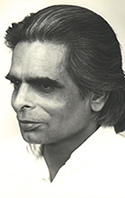To spread the original, universal and eternal truth, path or law of yoga, which remains forever the same in essence, yet always adapts to the time and place. |
|
"Nad" means movement. In the Rig Veda, it means stream. In Yoga, nadis are the channels of Kundalini energy.The Nadis thus are channels, but not only nerves (snayu). The subtle channels or Yoga Nadis are the channels of mind and the channels of chitta, the feeling self or being. The gross channels of subtle energy are visible as cords, vessels or tubes, including acupuncture meridians, nerves, muscles, arteries, veins, lymph,... Ayurveda mentions 72.000 different Nadis. Tantra Yoga identifies 14 principal nadis of which the following three are the most important :
The Kuhu Nadi for example causes ejaculation together with the Chitrini Nadi. The mastering of this nadi is the main objective of the Vajrauli exercise, allowing the male aspirant to raise the seminal fluid from the second chakra to the Soma Chakra within the Sahasrara Chakra, along with the vaginal fluid from his female counterpart. It is this practice which is often known as Tantric Sex, which created a lot of attraction to Tantra in the West. |
|
|
Related video : Full Class - The Seven Chakras (120')
 Sanatan Society is an international networking association of students of the late Harish Johari, joining efforts to promote his teachings of yoga philosophy, tantra, worship, art and love. Sanatan Society stands
for the original, universal and eternal truth, path or law of yoga.
Though it is Hindu in origin, Sanatan Society is not limited to any religion,
race, time or country, nor in fact to any particular organisation. More about Sanatan Society...
Sanatan Society is an international networking association of students of the late Harish Johari, joining efforts to promote his teachings of yoga philosophy, tantra, worship, art and love. Sanatan Society stands
for the original, universal and eternal truth, path or law of yoga.
Though it is Hindu in origin, Sanatan Society is not limited to any religion,
race, time or country, nor in fact to any particular organisation. More about Sanatan Society...